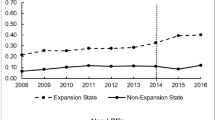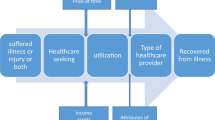Abstract
This study investigates individual-level misreporting among Medicaid recipients in Louisiana from 2007 to 2017. It explores whether the type of individual who misreports varies over time, including following a major policy shift (the implementation of the Affordable Care Act). Results are based on a series of biennial Medicaid Bias Studies from 2007 to 2017 in which Medicaid recipients are asked about their health care coverage, allowing us to identify individuals who misreport their status. Study participants are (1) randomly selected from state Medicaid files or (2) matched participants from a statewide health insurance survey designed to estimate uninsured rates. Survey respondents are asked a battery of questions designed to identify health insurance coverage for themselves and for each member residing within their household. Responses are then matched to Medicaid enrollment data to identify misreporting, including whether household members are misreported as uninsured, covered by an employer, or covered by some other government program. The results reveal that the level of Medicaid misreporting varies over time and that misreporting declined significantly following the Louisiana’s Medicaid expansion. As a result, careful estimation of Medicaid misreporting continues to be an important source of bias in estimates of health insurance coverage.
Similar content being viewed by others
Data availability
Data and code are available upon request from the authors.
Notes
Full reports of survey findings and the methodologies employed can be found at https://ldh.la.gov/index.cfm/newsroom/detail/3097.
The 2007 data were collected in the aftermath of Hurricane Katrina and the dislocations during this time period may have affected misreporting. Because the data included here begin in 2007, we are unable to draw any conclusions about the effect of Katrina on misreporting. For estimates of misreporting prior to 2007, see Goidel et al. (2007).
One may fairly note the distinction between SCHIP and Medicaid. In Louisiana, though the source of funding may be Medicaid directly or as SCHIP program, the state agency has promoted all programs as LaCHIP and participants identify the program as such.
The question of stability of misreporting for children is also clearly a topic of interest. For clarity, analytic results later presented in this paper focus on adults affected by the recent policy change. Future research will focus on updating misreporting results for children.
Robustness checks reveal that data source does not have a significant effect on misreporting. Including dummy variables indicating respondents selected from the administrative data (versus randomly selected for the Louisiana Health Insurance Survey) is not significant. In addition, we find no differences in results for individuals selected from random samples of cell phone (versus landline) telephone numbers. These results are available upon request.
The number of households in Louisiana in 2017 was 1,737,123 while the number of households sampled was 8500. While this is a small percentage, it is still a much larger sample than the CPS for Louisiana.
The methodology employed to determine insurance status requires respondents to provide information on other members of the household. Respondents are often reluctant to provide information that might be identifying. To encourage cooperation and to minimize these concerns, respondents are asked to only provide the first initial of respondents.
To capture whether differences in methodology affect our estimated results, we present models in the appendix including dummy variables indicating whether a respondent was interviewed on a landline telephone (versus a cell phone) and whether the respondent was selected from the Medicaid enrollment files (or was matched from the LHIS). These findings largely confirm results presented in the main text, though the interaction between race and 2017 is not statistically significant in these models.
The match rate varied across years: 79% in 2017; 83% in 2015; 83% in 2015; 77% in 2011; 84% in 2009; and 60% in 2007.
We should note that the bias we discuss here is not the bias due to misreporting, but rather a potential bias that occurs when pooling data over time or across space. More intuitively, smaller, pooled models include fewer variables and thus have smaller posterior standard deviations and credible sets. The cost of this gain in efficiency is potential bias. We return to this issue in the discussion of the probit results.
With an increase in the number of Medicaid recipients, you have a decrease in the percent misreporting and an increase in number misreporting.
According to one estimate, approximately 16 percent of the Louisiana Medicaid population is enrolled in Medicare (Young et al. 2013). We should also note that individuals who misreport as having private insurance may also have Medicaid. Given how the survey is set up, however, this still counts as “misreporting” as individual respondents are asked to identify all sources of coverage.
Hurricane Katrina made landfall in Louisiana in August 2005. The disruption caused by the hurricane, evacuations, and rebuilding may have resulted in more misreporting than is common in the typical year. For this reason, we used 2011 as a baseline year. While we suspect the higher levels of misreporting may reflect a “Katrina effect” we do not have convincing evidence.
Computations of marginal effects did not differ significantly from marginal effects computed at means for all variables.
References
Blumberg, S., Luke, J.V.: Wireless substitution: Early release of estimates from the national health interview survey, January–June 2020. https://www.cdc.gov/nchs/data/nhis/earlyrelease/wireless202102-508.pdf (2021). Accessed 1 July 2021
Baltagi, B.H., Bresson, G., Pirotte, A.: To pool or not to pool? In: Mátyás, L., Sevestre, P. (eds.) The econometrics of panel data, pp. 517–546. Springer, New York (2008)
Boudreaux, M.H., Call, K.T., Turner, J., Fried, B., O’Hara, B.: Measurement error in public health insurance reporting in the american community survey: evidence from record linkage. Health Serv. Res. 50(6), 1973–1995 (2015). https://doi.org/10.1111/1475-6773.12308
Boudreaux, M., Noon, J.M., Fried, B., Pascale, J.: Medicaid expansion and the Medicaid undercount in the American Community Survey. Health Serv. Res. 54(6), 1263–1272 (2019). https://doi.org/10.1111/1475-6773.13213
Call, K.T., Davidson, G., Sommers, A.S., Feldman, R., Farseth, P., Rockwood, T.: Uncovering the missing medicaid cases and assessing their bias for estimates of the uninsured. Inquiry 38(4), 396–408 (2001)
Call, K.T., Davidson, G., Davern, M., Brown, E.R., Kincheloe, J., Nelson, J.: Accuracy in self-reported health insurance coverage among Medicaid enrollees. Inquiry (00469580) 45(4), 438–456 (2008a)
Call, K.T., Davidson, G., Davern, M., Brown, E.R., Kincheloe, J., Nelson, J.G.: Accuracy in self-reported health insurance coverage among medicaid enrollees. INQUIRY J. Health Care Organ. Prov. Finan. 45(4), 438–456 (2008b). https://doi.org/10.5034/inquiryjrnl_45.04.438
Call, K.T., Davidson, G., Davern, M., Nyman, R.: Medicaid undercount and bias to estimates of uninsurance: new estimates and existing evidence. Health Serv. Res. 43(3), 901–914 (2008c). https://doi.org/10.1111/j.1475-6773.2007.00808.x
Call, K.T., Davern, M.E., Klerman, J.A., Lynch, V.: Comparing errors in medicaid reporting across surveys: evidence to date. Health Serv. Res. 48, 652–664 (2013). https://doi.org/10.1111/j.1475-6773.2012.01446.x
Cantor, J.C., Monheit, A.C., Brownlee, S., Schneider, C.: The adequacy of household survey data for evaluating the nongroup health insurance market. Health Serv. Res. 42(4), 1739–1757 (2007). https://doi.org/10.1111/j.1475-6773.2006.00662.x
Davern, M., Klerman, J.A., Baugh, D.K., Call, K.T., Greenberg, G.D.: An examination of the medicaid undercount in the current population survey: preliminary results from record linking. Health Serv. Res. 44(3), 965–987 (2009). https://doi.org/10.1111/j.1475-6773.2008.00941.x
Eberly, T., Pohl, M.B., Davis, S.: Undercounting Medicaid enrollment in Maryland: Testing the accuracy of the current population survey. Popul. Res. Policy Rev. 28(2), 221 (2009)
Goidel, K., Procopio, S., Schwalm, D., Terrell, D.: Implications of the medicaid undercount in a high-penetration medicaid state. Health Serv. Res. 42, 2424–2441 (2007)
Holbrook, A.L., Krosnick, J.A.: Social desirability bias in voter turnout reportsTests using the item count technique. Public Opin. Quart. 74(1), 37–67 (2010). https://doi.org/10.1093/poq/nfp065
Kincheloe, J., Brown, E.R., Frates, J., Call, K.T., Yen, W., Watkins, J.: Can we trust population surveys to count Medicaid enrollees and the uninsured? Health Aff. 25(4), 1163–1167 (2006)
Kreuter, F., Presser, S., Tourangeau, R.: Social desirability bias in CATI, IVR, and web surveysthe effects of mode and question sensitivity. Public Opin. Quart. 72(5), 847–865 (2008). https://doi.org/10.1093/poq/nfn063
Krumpal, I.: Determinants of social desirability bias in sensitive surveys: a literature review. Qual. Quant. 47(4), 2025–2047 (2013). https://doi.org/10.1007/s11135-011-9640-9
Lewis, K., Ellwood, M.R., Czajka, J.L.: Counting the uninsured: a review of the literature. Urban Institute, Washington (1998)
Mellor, J.M., McInerney, M., Sabik, L.M.: Misclassification of medicaid participation by dual eligibles: evidence from the medicare current beneficiary survey. Med. Care Res. Rev. 78, 113–124 (2019)
Noon, J.M., Fernandez, L.E., Porter, S.R.: Response error and the Medicaid undercount in the current population survey. Health Serv. Res. 54(1), 34–43 (2019)
Pascale, J., Boudreaux, M., King, R.: Understanding the new Current population survey health insurance questions. Health Serv. Res. 51(1), 240–261 (2016)
Pesaran, M.H., Smith, R.: Estimating long-run relationships from dynamic heterogeneous panels. J. Econ. 68(1), 79–113 (1995)
Swartz, K.: Interpreting the estimates from four national surveys of the number of people without health insurance. J. Econ. Soc. Meas. 14(3), 233–242 (1986)
Tourangeau, R., Yan, T.: Sensitive questions in surveys. Psychol. Bull. 133(5), 859 (2007)
Tourangeau, R., Rips, L.J., Rasinski, K.A.: The psychology of survey response. Cambridge University Press, Cambridge (2000)
Traugott, M.W., Katosh, J.P.: Response validity in surveysof voting behavior. Public Opin. Quart. 43(3), 359–377 (1979). https://doi.org/10.1086/268527
Funding
Louisiana Department of Health and Hospitals.
Author information
Authors and Affiliations
Corresponding author
Additional information
Publisher's Note
Springer Nature remains neutral with regard to jurisdictional claims in published maps and institutional affiliations.
Appendix
Appendix
In the appendix, we present several analyses to demonstrate the robustness of our findings. The first set of Tables 11, 12 show the results if we add in a dummy variable for respondents randomly selected from the Medicaid enrollment files. Inclusion of an indicator for selection from the Medicaid enrollment files does not affect model selection or our substantive interpretation of the findings.
In Table11, we then present the posterior descriptive statistics for coefficients of Model 2 for the full sample. The results qualitatively parallel those presented in the main text of the paper as expected though they cannot be interpreted as easily.
In Table 12, we then present the posterior descriptive statistics for coefficients of Model 6 for the full sample. The results provide additional detail on interaction impacts across year.
In Table 13, we then present the posterior descriptive statistics for coefficients of Model 2 for the respondent only sample. The results qualitatively parallel those presented in the main text of the paper paper as expected though they cannot be interpreted as easily.
In Table 14, we then present the posterior descriptive statistics for coefficients of Model 6 for the full sample. The results provide additional detail on interaction impacts across years and reveal large variation in predicted impact by year.
Rights and permissions
About this article
Cite this article
Barnes, S., Goidel, R.K., Terrell, D. et al. Is Medicaid misreporting stable over time? Self-reported health insurance coverage of Medicaid recipients in Louisiana, 2007–2017. Health Serv Outcomes Res Method 22, 253–274 (2022). https://doi.org/10.1007/s10742-021-00262-8
Received:
Revised:
Accepted:
Published:
Issue Date:
DOI: https://doi.org/10.1007/s10742-021-00262-8




